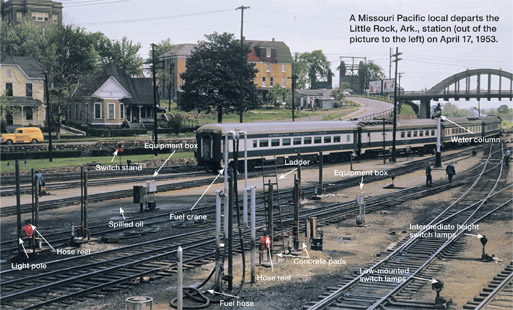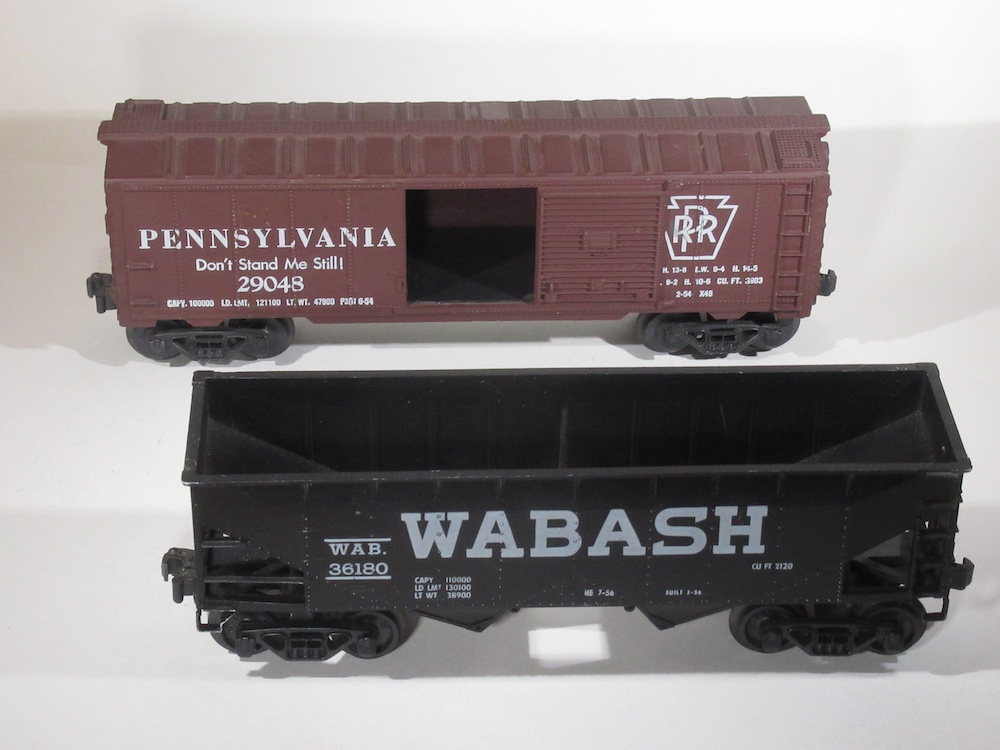
At first glance, the Little Rock passenger station seems like an odd place to refuel locomotives. After all, Missouri Pacific’s massive North Little Rock yard, roundhouse, and shop complex is just across the river. But this rudimentary facility makes perfect sense. Little Rock was a central location on the 11,547-mile MP system. Passenger locomotives arriving from distant points could be refueled, the steam generators used for train heating could be topped off, and the train was able to quickly resume its journey without a time-consuming detour through the congested yard and shop tracks.
When this photo was taken, steam locomotives were still active on the MP (the last was retired in 1955). The presence of the water column is a reminder that working steam locomotives required immense quantities of water. Railroads had good reason to be lavish in placing stand-pipes or tanks at convenient points.
Other photos in our collection show that the Little Rock station platforms were to the left of the photographer. To his right were a pair of large horizontal oil tanks flanking a modest wood-frame building that almost certainly housed fuel pumps.
Modeling this scene wouldn’t be difficult. The fuel cranes were scratchbuilt from styrene and brass shapes, and convincing hoses can be made from appropriately sized insulated electrical wire. Several companies offer switch stands and water columns.
Details are important. If we didn’t know this photo was taken in the early 1950s, we’d still be able to guess. That eye-catching bright yellow panel truck dates the scene nicely, and there are many other reminders of the past as well. For example, railroads were once more labor-intensive than they are today, and there are no less than four yard workers visible here. Don’t forget to add a few employees if you’re modeling the steam and early diesel era!
The kerosene switch lamps also speak of an earlier era in railroading, as does the oil-soaked ground. Federal spill prevention and containment regulations are a long way in the future. Those low stone retaining walls and that swath of bright-green grass that separate the railroad from the residential street would be interesting touches on a layout. The arched road bridge and elevated street is a tailor-made view block – particularly if it was specifically located there to hide a sharp turn. The railroad does curve sharply here in order to cross the Arkansas River (the lift bridge towers are visible above the road).
Paying attention to the details unlocks the modeling potential in this simple fueling area.
Interested in modeling locomotive terminals? Click here for Tony Koester’s Steam and Diesel Locomotive Servicing Terminals!














It is ok, The pic is too small, even after clicking on it.
ALSO, the term transition era, is a little too broad to use here. I am doing transition era for Southern and it spanned from 1944-1948. Southern had officially swapped both passenger AND freight over to diesel by 1948. There were a few locally owned spurs that were operating in the area where Southern operated, but for the most part I cannot and a reputable magazine like this should properly specify that the transition period depended on how advanced their prototype was. Southern was the most state of the art and advanced ANYWHERE in the world.
is there a link to a larger version of the image, it's really hard to pick out the details discussed in the article.
Yea… this'll work. Thanks
What a good idea, especially when space is a great concern, it allows me to reconsider the way in which l am designing my new layout
This is just a little gem, let's have more of those!
Went through this yard several times on the Texas Eagle from St. Louis to Houston. Only say it at night when they changed engines.
A great article worthy of application on most layouts.
Great little article but the photo is too small. Can you make a larger photo available online to attach to the printed article?
To enlarge the photo, right click and select copy. Then paste the photo in Word or photo software. You should be able to then resize the image.
Way cool, this is a big help.
Interesting scene that could be easily modeled with purchased parts or through some scratch building……not much fire suppression gear there though…..one or two fire extinguishers would be a good addition to the scene. Good article, thanks.
I liked the article and thought it was well wrote.I'm modeling this era so it was helpful to me as an idea.
Excellent prototype but cannot enlarge the picture and see any details or read the captions. Not useful at all this way!
Another great idea that I hadn't thought of.
Well done and keep them coming please. It all helps in my planning and modelling.
I like it simple and compact my layout is on the small side so im excited to find something in my size as far as maintence is concerned
thank you as help when look for transport time at deport.
A well written and informative artical.